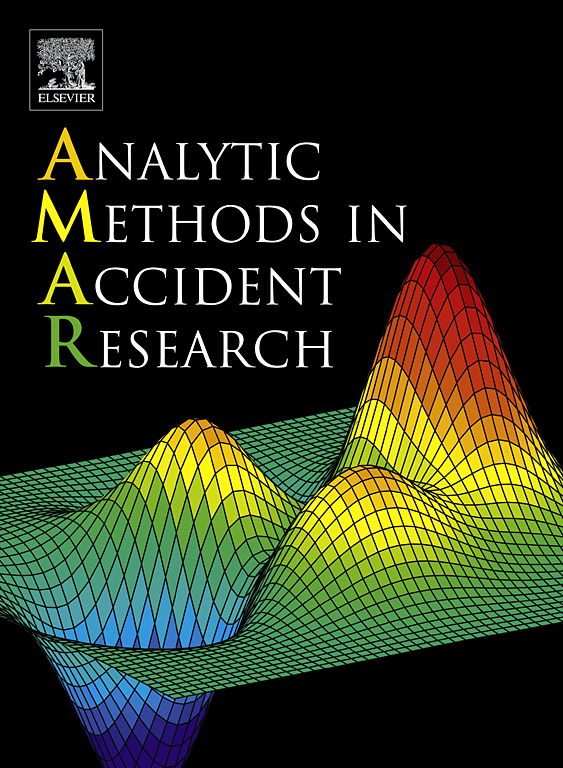评估COVID-19对固定物体乘用车碰撞中驾驶员损伤严重程度的影响:来自时间和部分约束建模分析的见解
IF 12.6
1区 工程技术
Q1 PUBLIC, ENVIRONMENTAL & OCCUPATIONAL HEALTH
引用次数: 0
摘要
新冠肺炎疫情重塑了包括美国在内的全球交通运输行业,造成了交通模式的前所未有的转变。尽管车辆行驶里程(VMT)减少了,但碰撞严重程度,尤其是死亡人数,却显著增加。在所有类型的碰撞中,固定物体碰撞由于其不成比例的高死亡率而一直构成严重的安全问题,这一趋势在大流行期间进一步加剧。本研究考察了COVID-19对俄勒冈州固定物体乘用车碰撞中驾驶员受伤严重程度的影响。作者估计了三个不同时间段内固定物体乘用车碰撞中驾驶员伤害严重程度的独立无约束模型:大流行之前(2019年3月- 2020年2月)、大流行期间(2020年3月- 2021年2月)和大流行之后(2021年3月- 2022年2月),以及利用随机参数多项logit模型的部分约束模型,该模型结合了随机参数均值和方差的异质性。该分析利用了从俄勒冈州交通部获得的22522起俄勒冈州的撞车记录。进行似然比检验以评估三个时间段内模型参数估计的时间不稳定性,并比较部分约束和无约束模型。研究结果表明,伤害严重程度的决定因素存在显著的时间差异,包括驾驶员属性、碰撞环境、道路特征和环境因素。虽然饮酒、不当驾驶和与树木的碰撞在所有时期都会影响伤害的严重程度,但性别、安全气囊部署、超速、季节变化和路面状况等因素的影响也在不断变化。样本外预测表明,固定物体碰撞造成的严重伤害一直被低估,这突显出人们对碰撞严重程度日益增加的担忧,特别是在大流行后时期。本文章由计算机程序翻译,如有差异,请以英文原文为准。
Assessing the impact of COVID-19 on driver injury severities in fixed-object passenger car crashes: Insights from temporal and partially constrained modeling analysis
The COVID-19 pandemic reshaped the global transportation sector, including in the U.S., creating an unprecedented shift in traffic patterns. Despite a reduction in vehicle miles traveled (VMT), crash severity, particularly fatalities, increased significantly. Among all crash types, fixed-object collisions have consistently posed a critical safety concern due to their disproportionately high fatality rates, a trend further exacerbated during the pandemic. This study examines the impact of COVID-19 on driver injury severity in fixed-object passenger car crashes in Oregon. The authors estimated separate unconstrained models of driver injury severity in fixed-object passenger car crashes across three distinct time periods: before pandemic (March 2019–February 2020), during pandemic (March 2020–February 2021), and after pandemic (March 2021–February 2022), as well as a partially constrained model utilizing a random parameters multinomial logit model that incorporates heterogeneity in both means and variances of the random parameters. The analysis utilized 22,522 crash records for the state of Oregon obtained from the Oregon Department of Transportation. Likelihood ratio tests were performed to assess the temporal instability of model parameter estimates throughout the three time periods and to compare the partially constrained and unconstrained models. The findings indicated notable temporal variations in the determinants of injury severity, encompassing driver attributes, crash circumstances, roadway characteristics, and environmental elements. While alcohol consumption, improper driving, and collisions with trees consistently influenced injury severity across all periods, factors such as gender, airbag deployment, speeding, seasonal variations, and road surface conditions exhibited changing effects. Out-of-sample predictions indicate that severe injuries in fixed-object crashes were consistently underestimated, highlighting growing concerns about increasing crash severity, particularly in the post-pandemic period.
求助全文
通过发布文献求助,成功后即可免费获取论文全文。
去求助
来源期刊

Analytic Methods in Accident Research
Multiple-
CiteScore
22.10
自引率
34.10%
发文量
35
审稿时长
24 days
期刊介绍:
Analytic Methods in Accident Research is a journal that publishes articles related to the development and application of advanced statistical and econometric methods in studying vehicle crashes and other accidents. The journal aims to demonstrate how these innovative approaches can provide new insights into the factors influencing the occurrence and severity of accidents, thereby offering guidance for implementing appropriate preventive measures. While the journal primarily focuses on the analytic approach, it also accepts articles covering various aspects of transportation safety (such as road, pedestrian, air, rail, and water safety), construction safety, and other areas where human behavior, machine failures, or system failures lead to property damage or bodily harm.
 求助内容:
求助内容: 应助结果提醒方式:
应助结果提醒方式:


